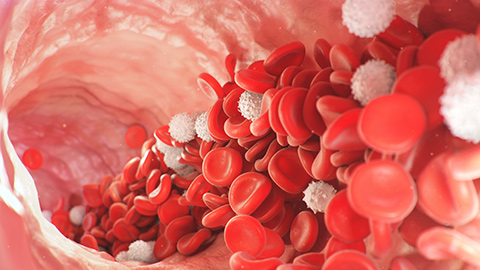
Another episode about DVT and pulmonary embolism—but this one looks really different from last week!
- New client says, “I want to make you aware of my pulmonary embolism this week . . . my hospitalist says massage will be OK”
- Encouragement to do massage
- Encouragement NOT to do massage
What to do??? In the face of contradictory advice, we walk through this decision-making process, discussing the difference between information and permission along the way.
Resources:
“Deep Vein Thrombosis (DVT)” Cleveland Clinic. Last modified July 18, 2019. https://my.clevelandclinic.org/health/diseases/16911-deep-vein-thrombosis-dvt.
Oppelt, P., A. Betbadal, and L. Nayak. “Approach to Chemotherapy-Associated Thrombosis.” Vascular Medicine 20, no. 2, 153–61. https://doi.org/10.1177/1358863X14568705.
Williamson, Laura. “After Years of Decline, Death Rate from Lung Clots on the Rise.” August 17, 2020. www.heart.org/en/news/2020/08/17/after-years-of-decline-death-rate-from-lung-clots-on-the-rise.


This podcast sponsored by:
About Anatomy Trains:
Anatomy Trains is a global leader in online anatomy education and also provides in-classroom certification programs forstructuralintegration in the US, Canada, Australia, Europe, Japan, and China, as well as fresh-tissue cadaverdissectionlabs and weekend courses. The work of Anatomy Trains originated with founder Tom Myers, who mapped the human body into 13 myofascial meridians in his original book, currently in itsfourthedition and translated into 12 languages. The principles of Anatomy Trains are used by osteopaths,physicaltherapists,bodyworkers,massagetherapists,personaltrainers,yoga,Pilates,Gyrotonics,and other body-minded manual therapists and movement professionals. Anatomy Trains inspires these practitioners to work with holistic anatomy in treating system-wide patterns to provide improved client outcomes in terms of structure and function.
Website:anatomytrains.com
Email:info@anatomytrains.com
Facebook:facebook.com/AnatomyTrains
Instagram: instagram.com/anatomytrainsofficial
YouTube:www.youtube.com/channel/UC2g6TOEFrX4b-CigknssKHA
About Coaching The Body:
CoachingTheBody™ is a highly unique approach to therapeutic bodywork that integrates traditional Thai massage techniques, trigger point therapy, and modern neuroscience as a means of efficiently treating pain and restoring normal motion across joints.Manual therapists and movement professionals all over the world have used the CoachingTheBody™ approach to relieve pain, unravel complex conditions, and grow their practices.CoachingTheBody™ offers both in-person and online training, including a full CTB certification program consisting of 7 body area courses, an apprenticeship program,and a growing online course catalog.
Website: coachingthebody.com
Email:admissions@thaibodywork.com
Facebook:facebook.com/CoachingTheBodyInstitute
Instagram:instagram.com/coachingthebody
0:00:00.0 Speaker 1: Ruth Werner's best-selling book, A Massage Therapist's Guide to Pathology, is a highly regarded, comprehensive resource that sets the standard for pathology education. Written for massage therapy students and practitioners, this groundbreaking resource serves up a comprehensive review of the pathophysiology, signs, symptoms and treatment of more than 500 diseases and disorders. Learn more at booksofdiscovery.com. Frozen shoulder is a mysterious condition that many therapists struggle to resolve. Learn how to reprogramme chronic pain patterns like frozen shoulder in just one to three sessions by attending a new free web class from Coaching The Body. You'll learn the number one muscle influencing shoulder function and how to unlock it, the controversial reason why Coaching The Body says most shoulder massages are a waste of time, what never to do when treating trigger points, three hidden fiber pairings that set up almost all cases of shoulder pain, and much more. Seating for the free web class is limited. Go to coachingthebody.com/abmpshoulder to register now.
[music]
0:01:28.6 Speaker 2: Hi, and welcome to "I Have a Client Who... " Pathology Conversations with Ruth Werner, the podcast where I will discuss your real life stories about clients with conditions that are perplexing or confusing. I'm Ruth Werner, author of A Massage Therapist's Guide to Pathology, and I have spent decades studying, writing about, and teaching about where massage therapy intersects with diseases and conditions that might limit our clients' health. We almost always have something good to offer, even with our most challenged clients, but we need to figure out a way to do that safely, effectively and within our scope of practice. And sometimes, as we have all learned, that is harder than it looks.
0:02:15.5 S2: Last week on this podcast, we had a story from a massage therapist who had long experience, lots of education, and a client she had worked with weekly for over seven years, who was under treatment for cancer, pulmonary embolism and deep vein thrombosis. The therapist came up with a treatment plan that she thought was safe and appropriate, and I mostly agreed with her. This week, we have a different lens to look through for the problem of massage and deep vein thrombosis. It comes from one of my favorite places to look for great stories, the Massage Sloth Clubhouse, and just as a reminder, I never, ever, ever share stories in this podcast without getting permission from the people who post them. So I read your stories, and if I think there's something that I Have a Client Who... Listeners could benefit from, then I reach out to you, or of course, you could contact me at ihaveaclientwho@abmp.com, that's ihaveaclientwho, all one word, all lowercase, @abmp.com. And here is this week's story.
0:03:29.5 S2: I just received a message from a client who has an appointment with me tomorrow, not sure if I should massage her. Here's her message, "I wanna make you aware of my recent hospital stay on Saturday night for a pulmonary embolism. My daughter, a nurse practitioner who's quite protective of me, says it's fine to come for a massage. I do have two smaller blood clots around my left knee. The hospitalist said I could resume all activities even swimming laps after a few days from release from the hospital. This is my first pulmonary embolism, but I am returning to teaching today, and I'm really excited to see you because my body is craving a massage, but I totally understand if you do not feel comfortable. I await your reply.
0:04:17.1 S2: Right. So this client was in the hospital with a pulmonary embolism this week, and she still has two identified clots near her knee, and her daughter, who is a nurse practitioner, thinks massage will be fine, and her hospitalist, not her doctor, by the way, it says all activities would be fine a few days after being sent home. So this massage therapist then comes to Facebook for some input on whether she would move forward with this client. I mean, there are already two medical professionals, a nurse practitioner and a hospitalist, who say go right ahead. Well, the overwhelming consensus, at least in the clubhouse, and there were dozens, maybe hundreds of replies, range in the spectrum from absolutely not to get a doctor's note. As a pathology teacher, I like seeing people be really cautious about the risk of inadvertently causing damage to a client, and that risk is substantial in this situation. However, the emphasis on a doctor's clearance, a doctors note, a doctor's permission and so on, these things make my hackles rise just a bit.
0:05:30.4 S1: Now look, there's a lot we don't know about this client. We don't know what kinds of medications she's taking. We don't know what her usual levels of activity are, and it doesn't sound like this therapist has worked with her extensively in the past, so we don't really have any sense of her general resilience, do we? So being conservative and making decisions about massage therapy is smart, but what do we need to make good decisions? We need information, and information is different from permission. After lots and lots of guidance about delaying massage and getting a doctor's permission, here is what this massage therapist chose to do.
0:06:10.0 S2: She writes. "Thanks again. I just responded to her and let her know she needs a doctor's clearance and time to heal and to adjust to meds. Also, to let her know it's for her own safety and health to wait." And then later we heard a little bit more. She wrote, "My client just got back to me after I told her I wouldn't be massaging her tomorrow, and her response was, 'I just made my follow-up appointment with my doctor for tomorrow morning. She is very cautious, so I'm not sure she will give me orders for a massage tomorrow afternoon, but if she should think it's an okay idea, would you be willing? I understand if your insurance prohibits this, even with a doctor's referral.'"
0:06:51.0 S2: So some interesting things are happening here, aren't they? Again, I wanna emphasize how much I appreciate the caution this massage therapist is showing throughout the process. I like that she's conveyed and need for the client to have time to heal and adjust to her meds, but I'd still like to know what they are. And making the decision to wait based on the client's health and safety, rather than the massage therapist's risk for liability, that is excellent. And I love, love, love that the client will bring up with her very cautious doctor, the possibility of receiving massage.
0:07:29.5 S2: This is good on so many levels. It shows the client's willingness to follow the massage therapists advice, it introduces massage as a positive activity in this client's life to her doctor, and it opens the door for more communication about this very complex situation. I'm very intrigued by the client's idea of a doctor giving orders for a massage. I assume this means maybe getting a prescription for a massage in this context, and obviously that seems unlikely. And it's nice that the client is concerned about the massage therapist's insurance, even with a doctor's referral, but can you see where this is taking us? It takes us back to how much it's a good idea... No, to how much it is a requirement that massage therapists be able to make and then own their own decisions with the input of whatever sources of information are relevant and useful. Clearly, the client is in favour of massage, but at this point, that's not enough information, is it?
0:08:34.1 S2: The hospitalist and the nurse practitioner daughter are on board too, still not adequate. The massage therapist must also feel like the massage is a good idea. In order for a massage to take place, only two people have to give permission, the massage therapist and the client. You know who doesn't have to give permission? The doctor. I've said it before, and I know I will say it again. It is not a doctor's job to determine whether your work is safe, that's your job. You are the only person who can do it. Sometimes, and I agree that this case is definitely one of those times, a doctor's input can help a massage therapist make a good decision, but it's still the massage therapist's call.
0:09:26.1 S2: I've been involved in lots of stories where a doctor's recommendation about massage, made with all the best intentions, did not actually serve their patient's best interest. When we put today's story through a critical thinking machine, identifying the key question, this client wants to receive massage but the therapist isn't sure it's safe; identifying the important variables, this would include details about the client's health status and the therapist's skill sets; considering alternatives, which the therapist did when she brought this question into the public; choosing a plan and then evaluating whether that plan was effective. That's the whole critical thinking process, and this is where we seem to have landed. The massage therapist wants to delay massage until she gets more input from the doctor, outstanding.
0:10:22.5 S2: I strongly suggest that when the time comes for this client to receive massage, that the therapist also do some background research about deep vein thrombosis and pulmonary embolism, including things like what medications and side effects the client may have, the risk for post-thrombotic syndrome, and whether she has a vena cava filter. And those are all the things that we talked about in last week's Lots of Clots episode, so if you need more information, be sure and check that out. Then when it's time to touch, I hope and fully expect, based on how this massage therapist has shown her cautious nature so far, that that session will be loving and supportive and conservative.
0:11:06.7 S2: This client has been through a major event, one that kills about 100,000 people each year in this country. The role of massage in this context is purely for comfort, recovery and quality of life, not to enforce any changes to the qualities of her tissues. I wanna conclude with my deep thanks and appreciation for this therapist who was brave enough to bring her case forward, and then who was willing to let me use her experience as a learning opportunity here on "I Have a Client Who... " I hope this little walk through that decision-making process was helpful. Our ability to figure out decision points for client safety is a crucial part of our job, and it just doesn't get the attention it deserves.
0:11:52.7 S2: Hey everybody, thanks for listening to "I Have a Client Who... " Pathology Conversations with Ruth Werner. Remember, you can send me your I have a client who stories to ihaveaclientwho@abmp.com. That's ihaveaclientwho, all one word, all lowercase, @abmp.com. I can't wait to see what you send me and I'll see you next time.
0:12:18.5 Speaker 3: Anatomy Trains is excited to invite you to another exciting two-day dissection livestream specialty class. Deep dive into joints, April 24th and 25th. This advanced dissection livestream education experience is presented by Tom Myers and master dissector, Todd Garcia. In this two-day event, we will examine the blended nature of support for each of the joint areas. This special dissection livestream format allows us to explore more deeply subjects and areas of interest. Visit anatomytrains.com for details.